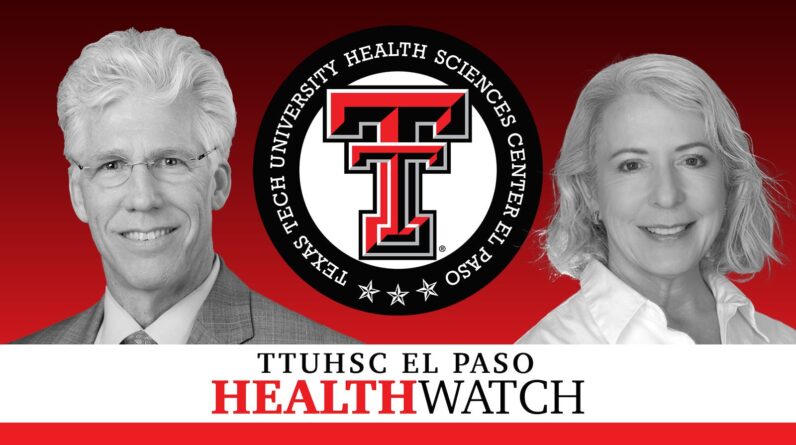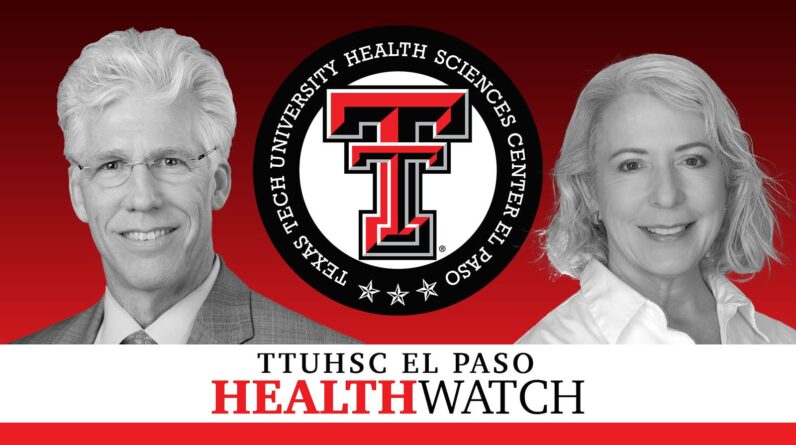
Health
TTHealthWatch is a weekly podcast from Texas Tech. In it, Elizabeth Tracey, director of digital media for Johns Hopkins Drugs in Baltimore, and Rick Lange, MD, president of the Texas Tech College Health and fitness Sciences Heart in El Paso, appear at the best professional medical tales of the week.
This week’s subject areas include things like innovations in dealing with early breast most cancers, stroke immediately after COVID vaccination, anti-seizure meds during pregnancy and ASD, and oxygen targets in critically unwell persons.
Application notes:
:38 Stroke soon after bivalent COVID vaccine
one:35 No increased risk with this vaccine by yourself
two:32 Public messaging
2:forty one Customized oxygen configurations for patients in the ICU
three:41 Lessen level resulted in a lot more days alive devoid of existence help
four:forty one Reducing blood glucose?
five:42 Confirm in randomized trials
6:43 Risk of autism in kids in mothers on anti-seizure meds during pregnancy
seven:forty three Elevated chance regardless of whether on medication or not
eight:forty six Remedy of early breast most cancers
nine:forty six CDK4/6 inhibitor
10:forty six No considerable aspect effects
eleven:37 More youthful than median age at diagnosis
twelve:sixteen Conclude
Transcript:
Elizabeth: Incremental advancements in managing early breast most cancers.
Rick: Danger of autism in little ones whose moms took anti-seizure medicines all through pregnancy.
Elizabeth: Personalized oxygen options if you happen to be in the ICU.
Rick: And does the COVID-19 bivalent vaccine result in stroke?
Elizabeth: That is what we are talking about this 7 days on TTHealthWatch, your weekly appear at the clinical headlines from Texas Tech University Wellness Sciences Middle in El Paso. I’m Elizabeth Tracey, a Baltimore-primarily based health-related journalist.
Rick: And I am Rick Lange, president of Texas Tech College Health and fitness Sciences Heart in El Paso, exactly where I’m also Dean of the Paul L. Foster School of Medicine.
Elizabeth: Rick, how about if we change ideal to JAMAwhich is using a appear at this concern of does the COVID vaccine improve one’s risk of stroke if one particular is an older grownup?
Rick: This review will come on the heels of a report in January of 2023 wherever the Food and drug administration and the CDC equally issued a joint community interaction that there was a preliminary protection sign — and this was a signal inside the Vaccine Basic safety Datalink surveillance program — that a stroke could be affiliated with the new COVID-19 bivalent vaccine.
What the investigators did is they utilised what’s identified as a self-controlled circumstance collection style and design in which persons acted as their individual controls. They seemed at over five million recipients of both brand of the COVID-19 bivalent vaccine.
The research identified that there was .two% that experienced some style of a stroke, but then when they as opposed this to the basic inhabitants there was no elevated hazard [of] stroke identified with the bivalent vaccine on your own. It can be reliable with other reports — for case in point, a equivalent report in France and Israel.
Nevertheless, that’s for persons that received the COVID vaccine by yourself. Individuals that gained COVID vaccine and the flu shot, there was a a little increased threat associated with the flu shot. I say a a little improved hazard it was not extremely constant. For instance, it didn’t transpire in the to start with 21 days. It took place concerning 21 and forty times and not following forty times. But it is pretty apparent that the COVID-19 vaccine is just not associated with greater stroke early on, in the mid-part or afterwards part.
Elizabeth: I am glad that there is surveillance of this, that people today are getting a look at it and following out potentials like this that are major, and putting the public’s mind at relaxation regarding acquiring vaccines. COVID has definitely presented us with a large amount of new situations, concomitant vaccines with equally flu and COVID.
Rick: Yep. I think, as you outlined, the study was completed and now we’re acquiring the community concept out that the COVID-19 vaccine is safe and sound and successful.
Elizabeth: Due to the fact we are speaking about COVID and we are in JAMAlet’s keep there. There are heading to be two reports that I am form of likely to talk about alongside one another. All those are associated to how a great deal supplemental oxygen should really we offer — what really should our concentrate on be — for individuals who are in the intensive treatment unit.
The first of all those offers with people who experienced COVID-19 and it randomized people, 726 grownups, with COVID-19 who ended up already getting some oxygen or mechanical ventilation in 11 ICUs in Europe from August 2020 to March 2023. Can we use ventilator options of 60 mm Hg — decrease oxygen — or ninety mm Hg? They seemed at their outcomes up to 90 times in the ICU. Their principal outcome measure was the variety of times alive without everyday living assistance, which I assumed was a very curious final result measure. They seemed at 697 people at the stop, and they have been capable to exhibit that in grownup ICU clients with COVID-19 and significant hypoxemia, this lessen amount, sixty mm Hg of oxygen, resulted in extra times alive with no lifestyle assist than focusing on the increased degree.
The other one is a modeling reviewgenerally using a seem at a few of studies and then making a device finding out product on the predicted result of cure with decrease versus greater oxygen ranges for unique sufferers. They applied that 1 information established to practice their product and then they stated, “How would this forecast what the proper point to do with regard to these oxygen targets is?”
This analyze also utilised a amount of extra individualized factors to say, “From time to time targeting a decrease oxygen degree is truly extra valuable than having the bigger one particular.” Modeling surely makes a speculation that wants to be examined in serious people to see how it turns out.
This total thing, of system, harkens again to me to scientific tests we talked over yrs in the past hunting at the fact that individuals produce this higher glucose degree in their blood when they are critically sick. Whilst we first assume that it would have been a very good notion to decrease it into what we imagine are regular physiologic levels for individuals who are not in the ICU, that resulted in poorer outcomes.
Just one of the editorialists about these research says if this modeling examine is borne out and we individualize oxygen stages based on no matter whether you have sepsis or you’ve got acquired some other rationale for remaining in the ICU, it would final result in so a lot reward, so quite a few a lot more patients keeping alive, if it turns out to be genuine.
Rick: We believe about the randomized controlled trial as staying form of the gold standard, but what occurs if the procedure is effective in some men and women and destructive in other people, and at the end it appears like there is no profit? What these authors tried to do is say, “Wait a minute — it’s possible giving everybody 100% oxygen is not the finest thing.”
By the way, we know it really is not, for instance, in youngsters. It can trigger much more lung concerns. It appears to be like like the very same thing in adults as well. Let’s see which may possibly benefit from greater oxygen, which could advantage from reduce oxygen, simply because possibly not everybody should be dealt with the same. Now, we need to have to verify that in much larger, randomized, managed trials, but I assume it reveals that not most people should really be handled the similar.
Elizabeth: That, of program, is the promise of AI in medication, that by some means we are going to be in a position to combine all of this data that will come from disparate populations, and integrate all of these unique aspects, and then say, “For you and your indication, the decrease oxygen amount would probably be far better” and so forth. I just however am struck by the point that the first speculation has turned out to be incorrect from many years of follow in conditions of oxygen concentrations in the ICU.
Rick: If you just acquire it as dogma and it hasn’t been seriously analyzed, in some cases you might be appropriate and at times you’re not. Sometime around the upcoming two years we are going to have about 50,000 extra sufferers that have been dealt with with bigger or lessen oxygen ranges as effectively. We imagine about individualized medicine becoming linked to the genes and the genetic make-up. Properly, customized medicine may well be related to what brought you into the clinic in the to start with place and regardless of whether you really should receive better or decreased oxygen centered upon that.
Elizabeth: Let’s flip to NEJM.
Rick: I provide this up as the danger of autism in young children whose mothers took seizure medications through pregnancy. Anti-seizure medicines are truly reasonably commonly approved to gals of childbearing prospective for epilepsy, for ache, and psychiatric ailments. Anything at all that’s provided to a mom could have an impact on the fetus. For example, fetal publicity to valproate is related with neuropsychological impairments, while other anti-seizure medications like lamotrigine or topiramate may well not be.
What these investigators sought to look at is no matter whether these seizure medicines are related to autism in the baby. They looked at pregnant females and their kids within two healthcare databases in the United States over about a two-10 years period of time from 2000 to 2020. They seemed at the incidence of autism spectrum condition at eight decades over these two huge populations.
Some of these moms experienced obtained topiramate, some experienced been given lamotrigine, and some experienced gained valproate. If a mom needed any of these or she just had this seizure ailment, it elevated the risk of owning an autistic kid. Youngsters born to mothers with epilepsy throughout the inhabitants, the incidence of autism was 4.two% with no exposure to anti-seizure treatment and it was a few-fold greater in all those who been given valproate, but no variation in people that obtained lamotrigine or topiramate.
Elizabeth: This, of class, is a seriously significant issue to take into consideration for the reason that we have been viewing the costs of autism spectrum ailment rise a whole lot.
Rick: Yep. It isn’t going to offer any insight into the system.
Elizabeth: Is there any facts in right here on how typically this one agent is seriously the only efficient agent for gals with seizure ailments?
Rick: There is not. It isn’t going to provide any data about no matter if these moms had been tried out on many medications or why they ended up notably set on valproate.
Elizabeth: Appropriate now then what would you say to a female who has a seizure disorder and is contemplating of getting to be pregnant?
Rick: I believe these moms should really chat to their physicians and see if there is a possibility if they could be set on a diverse agent.
Elizabeth: Remaining in the New England Journal of Medication then, let us look at this issue of dealing with early breast cancer with an agent identified as ribociclib and which is extra to one more agent in this unique demo. This was an intercontinental, open up-label, randomized, section III trial with sufferers with HR-constructive, HER2-damaging, early breast cancer.
It turns out that this is the most popular subtype of breast cancer out there, accounting for 70% to 75% of scenarios worldwide. Most of these cases are identified early, phase one to three, and this HR-beneficial, HER2-detrimental, early breast most cancers is ordinarily treated with surgery with or devoid of radiotherapy or chemotherapy, followed by adjuvant endocrine remedy for 5 to ten many years. Even so, their recurrence takes place in 27% to 37% of individuals with phase 2 ailment and forty six% to 57% of individuals with phase three disorder. That can proceed up to 20 a long time soon after prognosis, the hazard of that.
They consider a glimpse at what are referred to as CDK4/six inhibitors and aromatase inhibitors in these folks who have this analysis. Apparently, they do point out that guys also with early-stage breast most cancers account for some of the people who get this.
They had a complete of 426 sufferers who had invasive illness recurrence or death in the course of the time of this analyze. At 3 yrs, their invasive disorder-free survival was 90.4% with the ribociclib team in addition the aromatase inhibitor and 87.1% with the aromatase inhibitor by itself. This positive appears like including ribociclib to this is in all probability a very good idea.
Rick: Elizabeth, we are talking about an oral medicine that is taken on a daily foundation and these ladies took it for 3 yrs. Which is a 25% advancement and 1 would hope that even prolonged around a longer time period of time, 5 a long time or ten years, the survival would be even additional marked. The pleasant detail is there weren’t any sizeable side consequences connected with it.
Elizabeth: They do have facet effects, on the other hand — neutropenia, arthralgia, liver-linked occasions — and it did outcome in discontinuation in 3.3%. They also chat about this QT interval prolongation in five.2% in the ribociclib team and 1.two% in these who just took the aromatase inhibitor by yourself.
Rick: ninety five% to ninety seven% of the ladies tolerated this medication really well for stopping recurrent breast condition. That is very excellent.
Elizabeth: Yep, and including to the rewards of breast most cancers survival, at minimum in this nation. I would give kudos to the authors for noting that some of their limitations incorporate the simple fact that Black patients have been underrepresented in this demo, even however they are overrepresented with regard to breast most cancers. They were being also, their patients, younger than the median age at analysis in the United States and so on the lookout at these more expanded populations may perhaps improve this gain relatively.
Rick: I concur. It demands to be analyzed in different populations to see no matter whether the benefit extends to them as perfectly.
Elizabeth: On that notice then, which is the glance at this week’s health-related headlines from Texas Tech. I’m Elizabeth Tracey.
Rick: And I’m Rick Lange. Y’all listen up and make balanced decisions.





